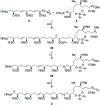A highly convergent synthesis of the C1-C31 polyol domain of amphidinol 3 featuring a TST-RCM reaction: confirmation of the revised relative stereochemistry
- PMID: 28757956
- PMCID: PMC5507186
- DOI: 10.1039/c5sc00814j
A highly convergent synthesis of the C1-C31 polyol domain of amphidinol 3 featuring a TST-RCM reaction: confirmation of the revised relative stereochemistry
Abstract
The concise enantioselective synthesis of the revised C1-C31 fragment of the polyketide amphidinol 3 was accomplished in 16 steps and 12.8% overall yield. Salient features of the strategy include chemoselective Weinreb amide coupling and concomitant CBS reduction for the preparation of the C1-C15 tris-syn-1,5-diol motif and a temporary silicon-tethered ring-closing metathesis (TST-RCM) reaction in combination with a diastereoselective hydroboration for the construction of the C16-C31 polypropionate fragment. The union of the fragments was accomplished by a regioselective ring-opening of the terminal epoxide with a phenyl sulfone stabilized carbanion, which upon reduction and deprotection permits a comparison of the relative configuration with the natural product.
Figures









Similar articles
-
Enantioselective total synthesis of the potent antitumor agent (-)-mucocin using a temporary silicon-tethered ring-closing metathesis cross-coupling reaction.J Am Chem Soc. 2003 Dec 3;125(48):14702-3. doi: 10.1021/ja0384734. J Am Chem Soc. 2003. PMID: 14640634 Free PMC article.
-
Synthesis of the C1-C52 fragment of amphidinol 3, featuring a beta-alkoxy alkyllithium addition reaction.Org Lett. 2007 Nov 8;9(23):4757-60. doi: 10.1021/ol7020934. Epub 2007 Oct 18. Org Lett. 2007. PMID: 17944478 Free PMC article.
-
Bidirectional cross metathesis and ring-closing metathesis/ring opening of a C 2-symmetric building block: a strategy for the synthesis of decanolide natural products.Beilstein J Org Chem. 2013 Nov 18;9:2544-55. doi: 10.3762/bjoc.9.289. eCollection 2013. Beilstein J Org Chem. 2013. PMID: 24367418 Free PMC article.
-
Total synthesis of phorboxazole A via de novo oxazole formation: convergent total synthesis.J Am Chem Soc. 2011 Feb 9;133(5):1506-16. doi: 10.1021/ja1089099. Epub 2010 Dec 29. J Am Chem Soc. 2011. PMID: 21190384
-
Ring-closing metathesis as a basis for the construction of aromatic compounds.Angew Chem Int Ed Engl. 2006 Apr 21;45(17):2664-70. doi: 10.1002/anie.200503512. Angew Chem Int Ed Engl. 2006. PMID: 16548035 Review.
Cited by
-
(Z)-α-Boryl-crotylboron reagents via Z-selective alkene isomerization and application to stereoselective syntheses of (E)-δ-boryl-syn-homoallylic alcohols.Chem Sci. 2019 Feb 26;10(12):3637-3642. doi: 10.1039/c9sc00226j. eCollection 2019 Mar 28. Chem Sci. 2019. PMID: 30996958 Free PMC article.
-
Synthesis of the C9-C25 Subunit of Spirastrellolide B.Org Lett. 2016 Jul 1;18(13):3094-7. doi: 10.1021/acs.orglett.6b01248. Epub 2016 Jun 14. Org Lett. 2016. PMID: 27300267 Free PMC article.
-
Application of Hosomi-Sakurai allylation reaction in total synthesis of biologically active natural products.Front Chem. 2025 Mar 28;13:1527387. doi: 10.3389/fchem.2025.1527387. eCollection 2025. Front Chem. 2025. PMID: 40224221 Free PMC article. Review.
-
The Chemistry of Phytoplankton.Chem Rev. 2024 Dec 11;124(23):13099-13177. doi: 10.1021/acs.chemrev.4c00177. Epub 2024 Nov 21. Chem Rev. 2024. PMID: 39571071 Free PMC article. Review.
References
-
-
For isolation, structural characterization and bioactivity evaluation of the amphidinol family, see:
- Satake M., Murata M., Yasumoto T., Fujita T., Naoki H. J. Am. Chem. Soc. 1991;113:9859.
- Paul G. K., Matsumori N., Murata M., Tachibana K. Tetrahedron Lett. 1995;36:6279.
- Paul G. K., Matsumori N., Konoki K., Sasaki M., Murata M. and Tachibana K., in Harmful and Toxic Algal Blooms, Proceedings of the Seventh International Conference on Toxic Phytoplankton, ed. T. Yasumoto, Y. Oshima and Y. Fukuyo, UNESCO, Sendai, Japan, 1996, p. 503.
- Paul G. K., Matsumori N., Konoki K., Murata M., Tachibana K. J. Mar. Biotechnol. 1997;5:124.
- Echigoya R., Rhodes L., Oshima Y., Satake M. Harmful Algae. 2005;4:383.
- Morsy N., Matsuoka S., Houdai T., Matsumori N., Adachi S., Murata M., Iwashita T., Fujita T. Tetrahedron. 2005;61:8606.
- Morsy N., Houdai T., Matsuoka S., Matsumori N., Adachi S., Oishi T., Murata M., Iwashita T., Fujita T. Bioorg. Med. Chem. 2006;14:6548. - PubMed
- Meng Y., Van Wagoner R. M., Misner I., Tomas C., Wright J. L. C. J. Nat. Prod. 2010;73:409. - PubMed
- Nuzzo G., Cutignano A., Sardo A., Fontana A., J. Nat. Prod., 2014, 77 , 1524 , and pertinent references therein . - PubMed
-
-
- For a recent report that proposes a barrel-stave pore model, see: Espiritu R. A., Matsumori N., Tsuda M., Murata M., Biochemistry, 2014, 53 , 3287 , and pertinent references cited therein . - PubMed
-
- For the original structural elucidation of amphidinol 3 (1), see: Murata M., Matsuoka S., Matsumori N., Paul G. K., Tachibana K., J. Am. Chem. Soc., 1999, 121 , 870 .
-
-
For structural revision of amphidinol 3 (1), see:
- Oishi T., Kanemoto M., Swasono R., Matsumori N., Murata M. Org. Lett. 2008;10:5203. - PubMed
- Swasono R. T., Kanemoto M., Matsumori N., Oishi T., Murata M. Heterocycles. 2011;82:1359.
- Manabe Y., Ebine M., Matsumori N., Murata M., Oishi T. J. Nat. Prod. 2012;75:2003. - PubMed
- Ebine M., Kanemoto M., Manabe Y., Konno Y., Sakai K., Matsumori N., Murata M., Oishi T. Org. Lett. 2013;15:2846. - PubMed
-
LinkOut - more resources
Full Text Sources
Other Literature Sources
Miscellaneous

